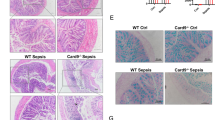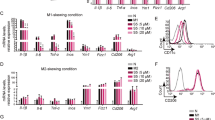Abstract
Background
The major mechanism of sepsis is immunosuppression caused by host response dysfunction. It has been found that α-Mangostin (α-M) is a potential candidate as a treatment for multiple inflammatory and immune disorders. To date, the role of α-M in host response during sepsis remains unexplored.
Methods and results
Herein, we examined the effect of α-M on macrophages-mediated host response in the presence of lipopolysaccharide (LPS), and the vital organ function, inflammatory response, and survival rate in septic mice. In murine peritoneal macrophages, α-M induced autophagy and then inhibited LPS-stimulated NLRP3 inflammasome activation, as well as interleukin-1β (IL-1β) production. Moreover, α-M improved phagocytosis and killing of macrophages, and increased M2 macrophages numbers after LPS stimulation. Furthermore, in vivo experiment suggested that α-M reduced serum levels of tumor necrosis factor-α (TNF-α), interferon-γ (IFN-γ), IL-1β, alanine transaminase (ALT), aspartate transaminase (AST), and creatinine (Cr), whilst increased that of interleukin-10 (IL-10) in caecal ligation and puncture (CLP) mice.
Conclusion
Taken together, these findings showed that α-M-mediated macrophages autophagy contributed to NLRP3 inflammasome inactivation and α-M exerted organ protection in septic mice.







Similar content being viewed by others
References
Shankar-Hari M, et al. Developing a new definition and assessing new clinical criteria for septic shock: for the third international consensus definitions for sepsis ans septic shock (sepsis-3). JAMA. 2016;315:775–87.
Sartelli M, et al. Raising concerns about the sepsis-3 definitions. World J Emerg Surg. 2018;13:6.
Hotchkiss RS, et al. Sepsis and septic shock. Nat Rev Dis Primers. 2016;2:16045.
Angus DC, Van der Poll T. Severe sepsis and septic shock. N Engl J Med. 2013;369:840–51.
Hotchkiss RS, Monneret G, Payen D. Sepsis-induced immunosuppression: from cellular dysfunctions to immunotherapy. Nat Rev Immunol. 2013;13:862–74.
Delano MJ, Ward PA. Sepsis-induced immune dysfunction: can immune therapies reduce mortality? J Clin Invest. 2016;126:23–31.
Cohen J, et al. Sepsis: a roadmap for future research. Lancet Infect Dis. 2015;15:581–614.
Jensen IJ, Sjaastad FV, Griffith TS, Badovinac VP. Sepsis-induced T cell immunoparalysis: the ins and outs of impaired T cell immunity. J Immunol. 2018;200:1543–53.
Savelkoel J, Claushuis TAM, vanEngelen TSR, Scheres LJJ, Wiersinga WJ. Global impact of World Sepsis Day on digital awareness of sepsis: an evaluation using Google Trends. Crit Care. 2018;22:61.
Anthony JL, Timothy RB, Matthew RR. Biology and metabolism of sepsis: innate immunity, bioenergetics, and autophagy. Surg Infect. 2016;17:286–93.
Zhang L, Ai YH, Tsung A. Clinical application: restoration of immune homeostasis by autophagy as a potential therapeutic target in sepsis (review). Exp Ther Med. 2016;12:1159–67.
Sridhar S, Botbol Y, Macian F, Cuervo AM. Autophagy and disease: always two sides to a problem. J pathol. 2012;226:255–73.
Choi AM, Ryter SW, Levine B. Autophagy in human health and disease. N Engl J Med. 2013;368:651–62.
Chen YQ, Klionsky DJ. The regulation of autophagy–unanswered questions. J Cell Sci. 2011;124:161–70.
Watanabe E, et al. Sepsis induces extensive autophagic vacuolization in hepatocytes: a clinical and laboratory-based study. Lab Invest. 2009;9:549–61.
Ho J, et al. Autophagy in sepsis: degradation into exhaustion? Autophagy. 2016;12:1073–82.
Chen G, Li Y, Wang W, Deng L. Bioactivity and pharmacological properties of α-mangostin from the mangosteen fruit: a review. Expert Opin Ther Pat. 2018;3:1–13.
Scolamiero G, Pazzini C, Bonafè F, Guarnieri C, Muscari C. Effects of α-mangostin on viability, growth and cohesion of multicellular spheroids derived from human breast cancer cell lines. Int J Med Sci. 2018;15:23–30.
Liu T, et al. Alpha-mangostin attenuates diabetic nephropathy in association with suppression of acid sphingomyelianse and endoplasmic reticulum stress. Biochem Biophys Res Commun. 2018;496:394–400.
Pan T, et al. Alpha-Mangostin suppresses interleukin-1β-induced apoptosis in rat chondrocytes by inhibiting the NF-κB signaling pathway and delays the progression of osteoarthritis in a rat model. Int Immunopharmacol. 2017;52:156–62.
Pimchan T, Maensiri D, Eumkeb G. Synergy and mechanism of action of α-mangostin and ceftazidime against ceftazidime-resistant Acinetobacter baumannii. Lett Appl Microbiol. 2017;65:285–91.
You BH, et al. α-Mangostin ameliorates dextran sulfate sodium-induced colitis through inhibition of NF-κB and MAPK pathways. Int Immunopharmacol. 2017;49:212–21.
Franceschelli S, et al. A novel biological role of α-mangostin in modulating inflammatory response through the activation of SIRT-1 signaling pathway. J Cell Physiol. 2016;231:2439–51.
Sivaranjani M, et al. In vitro activity of alpha-mangostin in killing and eradicating Staphylococcus epidermidis RP62A biofilms. Appl Microbiol Biotechnol. 2017;101:3349–59.
Chen ZL, et al. Transferrin-modified liposome promotes α-mangostin to penetrate the blood-brain barrier. Nanomedicine. 2016;12:421–30.
Catorce MN, et al. Alpha-mangostin attenuates brain inflammation induced by peripheral lipopolysaccharide administration in C57BL/6J mice. J Neuroimmunol. 2016;297:20–7.
Patil NK, Bohannon JK, Sherwood ER. Immunotherapy: a promising approach to reverse sepsis-induced immunosuppression. Pharmacol Res. 2016;111:688–702.
Yadav H, Cartin-Ceba R. Balance between hyperinflammation and immunosuppression in sepsis. Semin Respir Crit Care Med. 2016;37:42.
Fattahi F, Ward PA. Understanding immunosuppression after sepsis. Immunity. 2017;47:3.
Venet F, Rimmelé T, Monneret G. Management of sepsis-induced immunosuppression. Crit Care Clin. 2018;34:97.
Cavaillon JM, Adib-Conquy M. Monocytes/macrophages and sepsis. Crit Care Med. 2005;33(Suppl):S506–9.
Rabani R, et al. Mesenchymal stem cells enhance NOX2 dependent ROS production and bacterial killing in macrophages during sepsis. Eur Respir J. 2018;8:1702021.
Liu Y, et al. Scutellarin Suppresses NLRP3 inflammasome activation in macrophages and protects mice against bacterial sepsis. Front Pharmacol. 2018;8:975.
Xing L, et al. Role of M2 Macrophages in Sepsis-Induced Acute Kidney Injury. Shock. 2017;1:233–9.
Linch SN, Danielson ET, Kelly AM, Lee JJ, Gold JA. The effect of IL-5 on macrophages and PMNs in sepsis. Am J Resp Crit Care. 2009;179:A1024.
Lu XJ, et al. LECT2 protects mice against bacterial sepsis by activating macrophages via the CD209a receptor. J Exp Med. 2013;210:5–13.
Wang Y, et al. Alpha- mangostin, a polyphenolic xanthone derivative from mangosteen, attenuates beta-amyloid oligomers-induced neurotoxicity by inhibiting amyloid aggregation. Neuropharmacology. 2012;62:871–81.
Jin L, Batra S, Jeyaseelan S. Deletion of Nlrp3 augments survival during polymicrobial sepsis by decreasing autophagy and enhancing phagocytosis. J Immunol. 2017;198:1253–62.
Long H, Xu B, Luo Y, Luo K. Artemisinin protects mice against burn sepsis through inhibiting NLRP3 inflammasome activation. Am J Emerg Med. 2016;34:772–7.
Wu D, et al. Intermedin1-53 protects cardiac fibroblasts by inhibiting NLRP3 inflammasome activation during sepsis. Inflammation. 2018;41:505–14.
Ohsumi Y. Historical landmarks of autophagy research. Cell Res. 2014;24:9–23.
Virgin HW, Levine B. Autophagy genes in immunity. Nat Immunol. 2009;10:461–70.
Author information
Authors and Affiliations
Contributions
YG, MH guaranteed integrity of the entire study. YG designed the research, wrote the paper, analyzed the data. XX, QL,YX conducted experiments. MH contributed to revise the paper. All authors critically reviewed the manuscript for important intellectual content and approved the final version.
Corresponding author
Additional information
Responsible Editor: John Di Battista.
Publisher's Note
Springer Nature remains neutral with regard to jurisdictional claims in published maps and institutional affiliations.
Rights and permissions
About this article
Cite this article
Ge, Y., Xu, X., Liang, Q. et al. α-Mangostin suppresses NLRP3 inflammasome activation via promoting autophagy in LPS-stimulated murine macrophages and protects against CLP-induced sepsis in mice. Inflamm. Res. 68, 471–479 (2019). https://doi.org/10.1007/s00011-019-01232-0
Received:
Revised:
Accepted:
Published:
Issue Date:
DOI: https://doi.org/10.1007/s00011-019-01232-0




